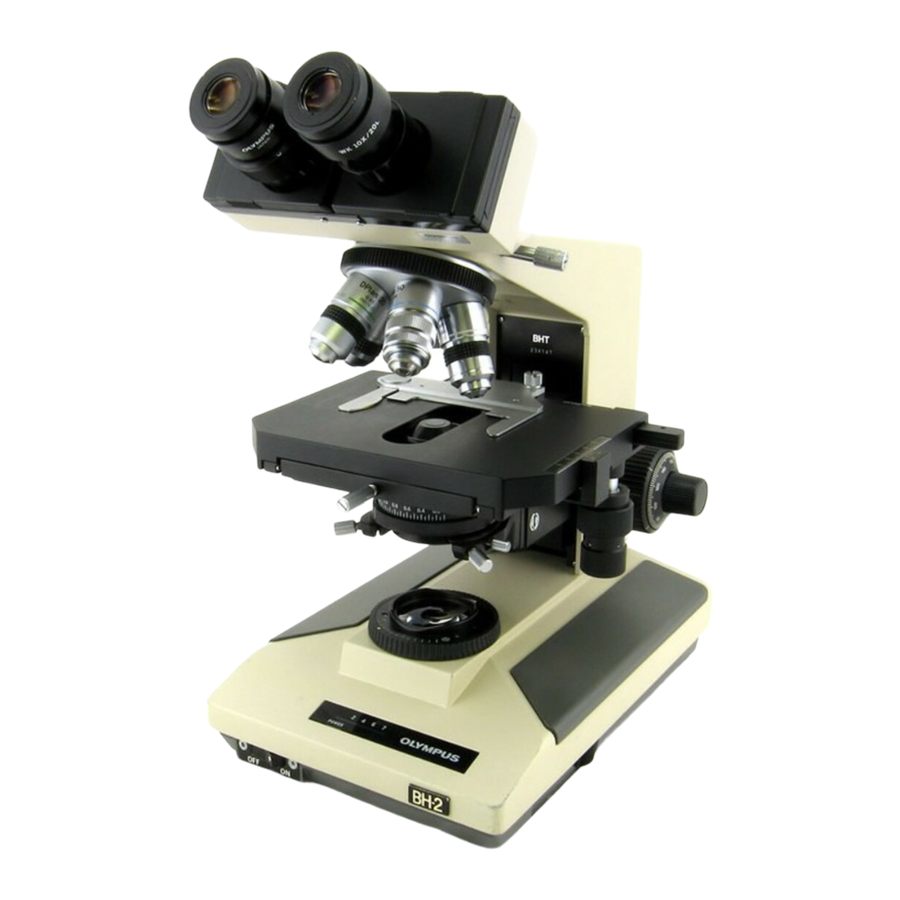Olympus BH2 Series Desmontaje, limpieza y montaje - Página 36
Navegue en línea o descargue pdf Desmontaje, limpieza y montaje para Microscopio Olympus BH2 Series. Olympus BH2 Series 45 páginas. Phase contrast
También para Olympus BH2 Series: Manual de solución de problemas y ajuste (46 páginas), Desmontaje, limpieza y montaje completos (23 páginas), Desmontaje, limpieza y montaje completos (40 páginas), Manual (6 páginas), Manual de instalación (9 páginas)

Using a flashlight if necessary, peer into the two tapped
holes in the base casting and adjust the position of the
Light Inlet Assembly until the two bite marks on the
outer surface of the metal barrel can be seen through
these two tapped holes.
witness marks to properly position the Light Inlet
Assembly, carefully position the Light Inlet Assembly
until the bite marks are well centered within the tapped
holes (see
Figure
151).
Figure 151 – Center the bite marks relative to the holes
Using a 1.3mm hex tool, reinstall the two m2.6x3
setscrews to secure the Light Inlet Assembly into the
bore of the base casting (see
setscrews bite into the original bite marks, the Light
Inlet Assembly will be locked in the same physical
position from which it was originally removed.
Figure 152 – Reinstall setscrews to secure the barrel
Light Exit Assembly
There were two distinct mechanical configurations of
the Light Exit Assembly used on the BH-2 microscopes.
These versions differ in the construction of the knurled
field-adjustment ring and the filter holder.
versions are shown in top view in
bottom view in
Figure
version on the left, and the all-plastic version on the
right, in both figures.
Teardown, Cleaning, and Reassembly of the Miscellaneous Parts of the Olympus BH-2 Microscope Frames
Using the bite marks as
Figure
152). When the
Figure 153
and in
154, with the plastic/metal
Figure 153 – Top view of the Light Exit Assemblies
Figure 154 – Bottom view of the Light Exit Assemblies
PLASTIC/METAL VERSION: The plastic/metal version, as
shown on the left-hand side of both
Figure 154,
the knurled plastic field-adjustment ring, with the brass
insert functioning as the bearing surface upon which
the knurled ring rotates (with a coating of grease). The
filter holder of this version is constructed of metal.
Since the plastic/metal design relies on grease to allow
the knurled ring to rotate freely, these are subject to
gumming up and becoming hard to rotate as the grease
ages.
ALL-PLASTIC VERSION: The all-plastic version, as shown
on the right-hand side of
utilizes an all-plastic knurled field-adjustment ring (i.e.,
without a brass insert) as well as a plastic filter holder.
The bearing surfaces of the all-plastic version are of
course plastic, and since this version did not include
grease (although a light oil is usually present in these),
Both
the field-adjustment ring on this version does not
typically stiffen up, since it contains no grease to gum
up the mechanism as it ages. Externally, these two
assemblies look very similar, as can be seen in
153.
utilizes a machined brass insert molded into
Figure 153
Revision 1
Figure 153
and
and
Figure
154,
Figure
Page 36 of 45
